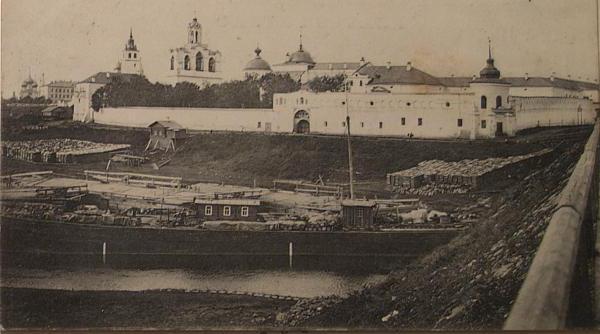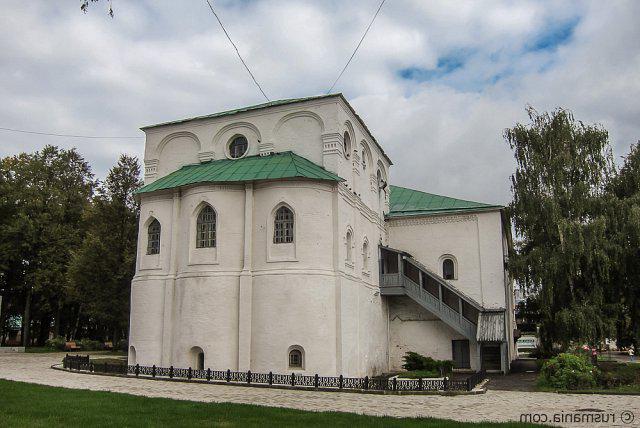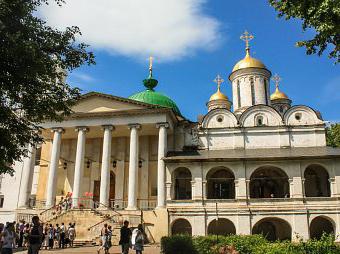The Transfiguration Monastery in Yaroslavl is the oldest building in the city. It was first written about him in a chronicle dated 1186. However, other sources claim that it was founded in the 13th century. Perhaps this is not the main date, since the first buildings of stone temples located on the territory of the monastery were erected in 1216-1224. This is evidenced by numerous documents. Most tourists visit Yaroslavl for a reason . The sights, the photos of which they saw in brochures, attracted them with their beauty, in particular - the image of the majestic monastery buildings.
History of creation
To have an idea of the exact location of the monastery, you should know where Yaroslavl is located on a map of Russia. The city is located on the Kotorosl River, near the Forest Glade, and belongs to the major cultural centers of Europe. On the left bank the Transfiguration Monastery in Yaroslavl was erected. The address of this attraction: Epiphany Square, d. 25. Initially, all the buildings and walls were made of wood. In the XIII century, the monastery received the patronage of Prince Konstantin from Yaroslavl, at the direction of which stone buildings and a temple were erected here. Thanks to the Yaroslavl ruler, a religious school was opened here - the only one in the north-eastern region of Russia. In the Spassky Monastery there was a rich library, which had many Greek, Russian books written by hand. Thus, this place became the cultural and religious center of the region. In the early 90s of the 18th century, it was here that the collector of antiquities Alexei Ivanovich Musin-Pushkin discovered the list of “Words on Igor's Regiment”, which other monasteries of Yaroslavl could not boast of.
general description
Currently, the Transfiguration Monastery in Yaroslavl is the oldest building that has survived to this day. It was erected on the foundation remaining from the first monastery of 1506-1516. The first cathedral was significantly damaged by the fire of 1501, so it was forced to be dismantled. The new church was built not by Yaroslavl, but by Moscow masters, who were sent from the capital at the direction of Vasily III, since before the accession to the Moscow throne, the prince ruled Yaroslavl. The architectural form of the monastery is somewhat similar to the churches of the Moscow Kremlin. The cathedral is surrounded by a gallery from two sides, has an open arcade. The gallery was built instead of an open “gulbische”; it served as a book depository at the monastery for a long period of time. Today, arched openings from the north of the gallery have been laid.

The contours of the cathedral are simple and strict, they are almost devoid of decorations, with the exception of a stepped gallery from the west. The facades culminate in large curtains and lack virtuoso decoration. Three high apses are equipped with narrow loophole windows. The cathedral is crowned with three chapters on massive light high drums, which are surrounded by small kokoshniks and encircled at the top by arcuate-columnar belts. This carved decor is the only decorating cathedral. Otherwise, the external decoration of the monastery is very strict, ascetic, conveys the severity of the times in which the temple was built. The basement of the cathedral was used as the tomb of the Yaroslavl princes, and at the end of the 17th century, lesser persons were buried there. One of the first cities that had many buildings in the monastery was Yaroslavl. Sights - the photo shows us this - appeared as a result of the construction of new buildings and the restoration of old ones.
Churches in the monastery
On the southeast side, the Transfiguration Cathedral adjoins a huge empire-style church, which was built in 1827-1831. in accordance with the project of the provincial architect Pyotr Yakovlevich Pankov. She completely blocked the view of the ancient cathedral from the south side. Previously, on this spot was a small Church of the entrance of Jerusalem, which was the same age as the first cathedral. It was in it that the relics of Yaroslavl miracle workers - the Holy Prince Fedor and his sons - David and Constantine were found.
As a result of the fire of 1501, she also suffered, but not as much as the cathedral itself, so she stood there for another hundred years, until a decision was made to rebuild it. The monastery and churches were especially revered by the Moscow princes. Even Ivan the Terrible himself visited them more than once. With his participation, the cathedral was painted, the monastery was celebrated with gifts, so 55 royal letters granted were preserved.
Monastery belfry
In the 16th century, a large belfry was erected on the square at the monastery, possibly pillar-shaped in the beginning; it was connected to the cathedral by a two-tier gallery. A temple was built in the lower part of the building; its apse is still visible from the east. By the middle of the XVI century, the belfry was expanded, they made a passage, crowning the top with two tents made of stone. The arches of the original tier of this building are still clearly visible.
The belfry received its modern look in the 19th century, at the same time as the construction of the church in honor of the wonderworkers. According to the ideas of the architect P.Ya. Pankova she was built on the third tier in a pseudo-Gothic style. Upstairs put a small rotunda in a classic style. In this eclectic form, which has grown significantly, it has come down to us, becoming the main high-altitude landmark of the center of Yaroslavl.
Monastic refectory
From the western part of the belfry, framing the area of the monastery, a huge refectory has been set up on two floors with the Christmas Church. It was built in the 16th century, perhaps even earlier than the cathedral itself. The center of this building consists of a spacious single-pillar chamber with arches in the form of a sail. It was intended for ceremonial receptions of distinguished guests, refectory events of a huge monastic fraternity. The vaults, as well as the walls of the chamber, were richly decorated with murals. In terms of beauty and beautification, this refectory was better than the metropolitan buildings of its time. So, the heating went through the vents from the kitchen center located below, the dishes were served from the cookery through specially equipped hatches. Below was a kitchen and utility rooms - pantries, a kvassarna. Residential quarters were also located on the second floor. The eastern part of the building is equipped with a refectory of the Nativity of Christ. This is a small temple, which stood on a towering basement. From the west, the chambers of the 17th-century abbot joined the chamber. The walls were deprived of outstanding decoration, except for simple platbands and pilasters.

Holy Gates of the monastery
At the beginning of the XVI century, instead of a wooden fence, stone fortifications were erected, including the exquisite Holy Gate. Initially, the eastern wall was closer to the belfry, and now an elongated cell building of the 1670-1790s is installed on its line. In 1516, the first stone tower of the monastery walls was erected - the Holy Gate, which overlooked the banks of the Kotorosl River. In the XVII century, the watch tower was also built up, it was a bell tower with a special alarm bell to report an alarm, outside the tower there was a zab - a kind of defensive structure that protected the entrance from possible enemy attacks. The tower is considered the main entrance, and its gate leads to the central square of the monastery. Initially, it was she was surrounded by a toothed belt, currently preserved only from the south. By the middle of the XVII century, in addition to the sentinel tower, the Vvedensky Gate Church with the completion in the form of a tent, which was heavily rebuilt already in the XIX century, was put on the Holy Gate, the tent was replaced by a primitive four-slope roof.
Building History
Gradually (in the 1550-1580s) all the existing wooden walls of the monastery were replaced by stone ones. The border of the monastery itself at that time passed from the eastern side, where the cell building is nowadays arranged. Strong stone walls were very welcome, because in 1609 the Polish-Lithuanian troops moved to Yaroslavl. The city itself was besieged, however, due to the mutual placement of the Kremlin and the monastery, it withstood a twenty-four-day siege, remaining unconquered. In 1612, the commanders of the Russian militia Prince Dmitry Pozharsky and the tradesman Kozma Minin were placed in the Transfiguration Monastery . A year later, for the wedding to the kingdom, Mikhail Romanov himself came to Yaroslavl. The Transfiguration Monastery crowned the future ruler with honors. Perhaps this explains the long patronage of the royal family to the Spassky Monastery.
The cell building and new buildings
At the end of the turmoil, the Transfiguration Monastery in Yaroslavl expands the territory. They began to build new walls equipped with towers. A rather long building with cells (in the 1670s and 1690s) is being built on the site of the old eastern wall.
The grandiose building was well thought out for comfortable housing:
- had a heating system;
- equipped with internal stairs:
- equipped with wall cabinets;
- had separate exits for each pair of cells.
Not all the towers were preserved in the fence of the monastery, some of them were later dismantled.
The following buildings survived:
- Mikhailovskaya tower.
- Bogoroditskaya tower.
- Uglich tower.
- Epiphany tower.
- Holy Gates.
- Water gate.
The further fate of the monastery
In the XVIII century, the monastery was abolished in accordance with the decree of Catherine II, proclaiming the secularization of church lands. The Transfiguration Monastery in Yaroslavl became the residence of the Yaroslavl and Rostov archbishops. Perestroika of the 19th century was carried out in accordance with the views of the Bishop's House. The former monastery still kept a rich library - a book depository, then a seminary opened. Thanks to this, Yaroslavl was marked on the map of Russia as a cultural capital.

In Soviet times, the monastery was closed. During the Yaroslavl uprising, many buildings were significantly damaged, but were again renovated in the 1920s. The temples and cells of the Transfiguration Monastery were used as housing, educational institutions, the military commissariat. And only since the 1950s, a full restoration was carried out, it was decided to place the Yaroslavl Historical and Architectural Museum-Reserve. He is the full owner of the monastery territory to this day. This grandiose building is very famous for the city of Yaroslavl. The Transfiguration Monastery, the photo of which is presented above, is a unique structure that looks truly magnificent and colossal.